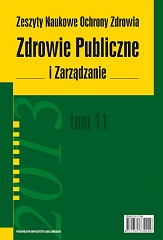Obciążenie pracą podczas ostatniego dyżuru w opiniach pielęgniarek pracujących w szpitalach objętych projektem RN4CAST
Workload during the last shift in the opinion of hospital nurses involved in RN4CAST project
Author(s): Maria Kózka, Maria Cisek, Piotr Brzyski, Krzysztof Gajda, Maria Ogarek, Lucyna Przewoźniak, Teresa Gabryś, Anna Ksykiewicz-Dorota, Tomasz BrzostekSubject(s): Social Sciences
Published by: Wydawnictwo Uniwersytetu Jagiellońskiego
Keywords: hospital; nursing; Registered Nurse Forecasting; shiftwork; work condition; workload
Summary/Abstract: The issue of workload is one of the most important ones as far as the nurses’ profession is concerned. Numerous analyses prove the relationship between excessive workload and job dissatisfaction, which may lead to low morale, absenteeism, high rotation and low work efficiency and, consequently, result in deterioration of the care provided to the patient and even put the patient’s safety at risk. RN4CAST project is aimed at the evaluation of the workload which the nurses are exposed to during their shifts. Such a survey focuses on all structural determinants of hospital workload depending on: type of the ward, professional role, number of patients and their health condition as well as work conditions and organization: the number of working hours and shift staffing. Aim of the survey The survey is aimed at determining the factors responsible for the workload which the nurses are exposed to during their shifts in hospitals involved in RN4CAST project. Material and Methods The study included 2605 nurses working in 30 acute hospitals in Poland. The respondents were mainly women. Men made up only 0.4% of the population examined. The average age was 40.3 (SD = 7.8 years old). 23.5% of the respondents had the Bachelor’s degree in nursing. The average seniority was 18.6 years (SD = 8,6), and the seniority in the hospital involved in the survey – 15.6 years (SD = 9,2). The material was collected by means of a survey and a structurised questionnaire completed by the nurses on their own. A correlational model was used to evaluate the workload determinants. Conclusions 1. The analysis of the findings shows that structural factors (such as type of the ward, professional role, number and condition of patients) as well as organisational factors (such as number of shift hours, shift staffing and work environment) determined the nurses’ workload. 2. The shift survey as a device for evaluating nurses’ workload should be recommended to ward nurses and hospital management because of the simplicity with which particular elements can be observed. The observation can be carried out during a relatively short period of time (8–12-hour shift), which allows for a better and faster explanation of the reasons of excessive workload and consequently may lead to implementing solutions, which would eliminate this negative phenomenon.
Journal: Zdrowie Publiczne i Zarządzanie
- Issue Year: 11/2013
- Issue No: 2
- Page Range: 210-224
- Page Count: 15
- Language: Polish

